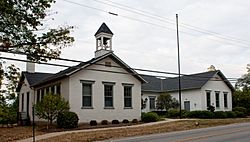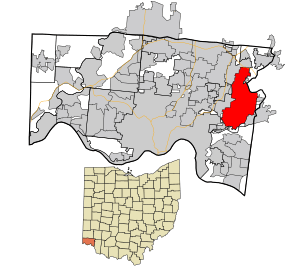Indian Hill, Ohio facts for kids
Quick facts for kids
The Village of Indian Hill, Ohio
|
|||||
|---|---|---|---|---|---|

Jefferson Schoolhouse
|
|||||
|
|||||

Location in Hamilton County and the state of Ohio
|
|||||
| Country | United States | ||||
| State | Ohio | ||||
| County | Hamilton | ||||
| Area | |||||
| • Total | 18.76 sq mi (48.59 km2) | ||||
| • Land | 18.67 sq mi (48.35 km2) | ||||
| • Water | 0.10 sq mi (0.25 km2) | ||||
| Elevation | 883 ft (269 m) | ||||
| Population
(2020)
|
|||||
| • Total | 6,087 | ||||
| • Estimate
(2022)
|
6,015 | ||||
| • Density | 326.08/sq mi (125.90/km2) | ||||
| Time zone | UTC-5 (Eastern (EST)) | ||||
| • Summer (DST) | UTC-4 (EDT) | ||||
| FIPS code | 39-76582 | ||||
| GNIS feature ID | 1086234 | ||||
The Village of Indian Hill is a city located in Hamilton County, Ohio, United States. It's a suburb of the larger Cincinnati area. In 2020, about 6,087 people lived there.
Even though it's called "The Village of Indian Hill," it's actually a city! This happened because in Ohio, if a village's population goes over 5,000, it becomes a city. Indian Hill reached this number in 1970.
Forbes magazine said that Indian Hill was one of the wealthiest places in Ohio in 2023. The average household income there was about $194,643 in 2021, and the average home value was around $918,000.
Contents
History of Indian Hill
Indian Hill started as a simple farming community. Farmers could easily ship their goods to Cincinnati using the nearby Little Miami Railroad.
Around 1904, people from Cincinnati began buying farmhouses in Indian Hill. They used these as places to relax on weekends away from the city. They would travel there by train.
In the early 1920s, four businessmen from Cincinnati bought homes in Indian Hill. They wanted to create a special rural area. In 1924, they formed the Camargo Realty Company. This company bought about 12,000 acres (4,856 hectares) of farmland. They then divided some of it into large plots, often 25 acres (10 hectares) each.
Soon, many grand mansions with stables and other buildings were built. Some of these were very large, like "Peterloon," which was 1,200 acres (485 hectares). Today, these large estates have been divided into smaller lots.
Every part of Indian Hill is set aside for single-family homes or for farming.
Geography of Indian Hill
Indian Hill covers an area of about 18.65 square miles (48.30 square kilometers). Most of this area is land, with a small amount of water.
The landscape in Indian Hill is very diverse. You can find flat, open fields, as well as thick forests with steep hills. There are also winding streams, dark pine tree areas, and interesting rock formations. You can even find many fossils there!
Population Facts
| Historical population | |||
|---|---|---|---|
| Census | Pop. | %± | |
| 1950 | 2,090 | — | |
| 1960 | 4,526 | 116.6% | |
| 1970 | 5,651 | 24.9% | |
| 1980 | 5,521 | −2.3% | |
| 1990 | 5,383 | −2.5% | |
| 2000 | 5,907 | 9.7% | |
| 2010 | 5,785 | −2.1% | |
| 2020 | 6,087 | 5.2% | |
| 2022 (est.) | 6,015 | 4.0% | |
| Sources: | |||
Indian Hill in 2020
In 2020, there were 6,087 people living in Indian Hill. The city had about 326 people per square mile (125.9 per square kilometer). There were 2,228 homes in the city.
Most of the people living in Indian Hill (86.9%) were White. About 7.1% were Asian, and 0.6% were Black or African American. About 2.2% of the population were Hispanic or Latino.
There were 2,364 households in Indian Hill. About 29.9% of these households had children under 18 living with them. Most households (84.8%) were married couples living together.
The average age of people in Indian Hill was 54.4 years old. About 23.1% of the people were under 18.
Indian Hill in 2010
In 2010, there were 5,785 people living in Indian Hill. The population density was about 311.9 people per square mile (120.5 per square kilometer).
Most residents (92.2%) were White. About 5.7% were Asian, and 0.7% were African American. About 1.6% of the population were Hispanic or Latino.
About 37.0% of homes had children under 18 living there. Most homes (80.2%) were married couples. The average age was 48.4 years. About 27% of residents were under 18.
Education in Indian Hill
Students in Indian Hill can attend public or private schools. The public schools are part of the Indian Hill Exempted Village School District.
This district includes:
- Indian Hill Primary School (for grades K-2)
- Indian Hill Elementary School (for grades 3-5)
- Indian Hill Middle School (for grades 6-8)
- Indian Hill High School (for grades 9-12)
The district also serves students from parts of Symmes Township and Sycamore Township. For private school, many students attend Cincinnati Country Day School.
Notable people
Many well-known people have lived in Indian Hill, including:
- Neil Armstrong, the first person to walk on the Moon
- William DeWitt Jr., who leads the St. Louis Cardinals baseball team
- Peter Frampton, a famous rock musician
- Mat Latos, a professional baseball pitcher
- Marvin Lewis, a former coach for the Cincinnati Bengals football team
- Carson Palmer, a former American football quarterback
- Marge Schott, a former owner of the Cincinnati Reds baseball team
- Potter Stewart, who was a judge on the United States Supreme Court
- Robert A. Taft, an important American politician
- J. J. Wolf, a tennis player
See also
 In Spanish: The Village of Indian Hill para niños
In Spanish: The Village of Indian Hill para niños



